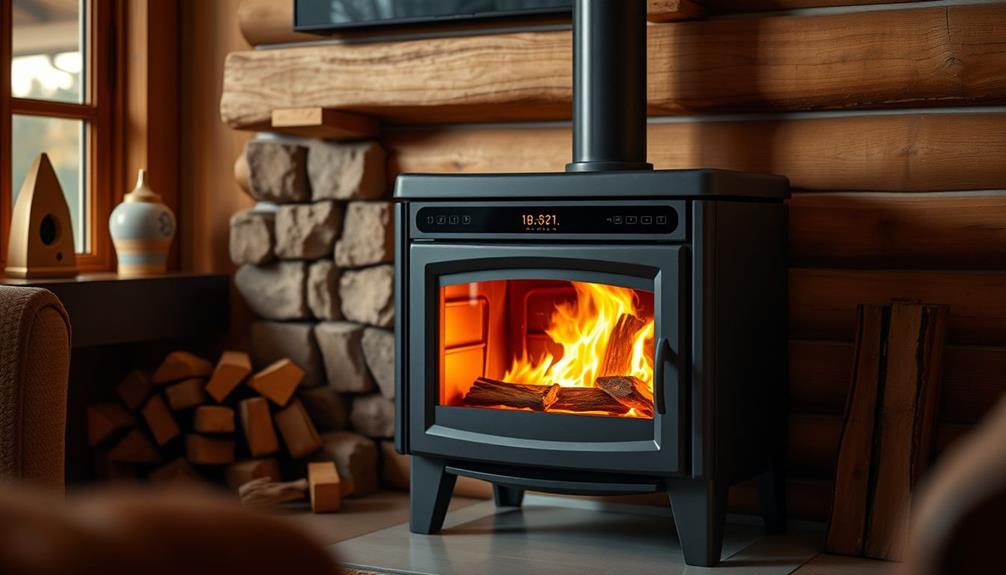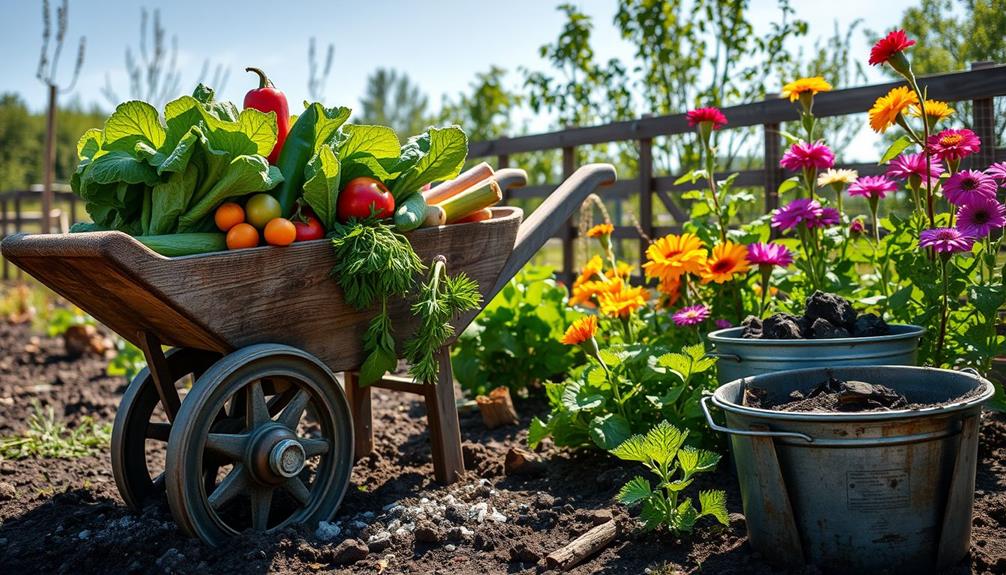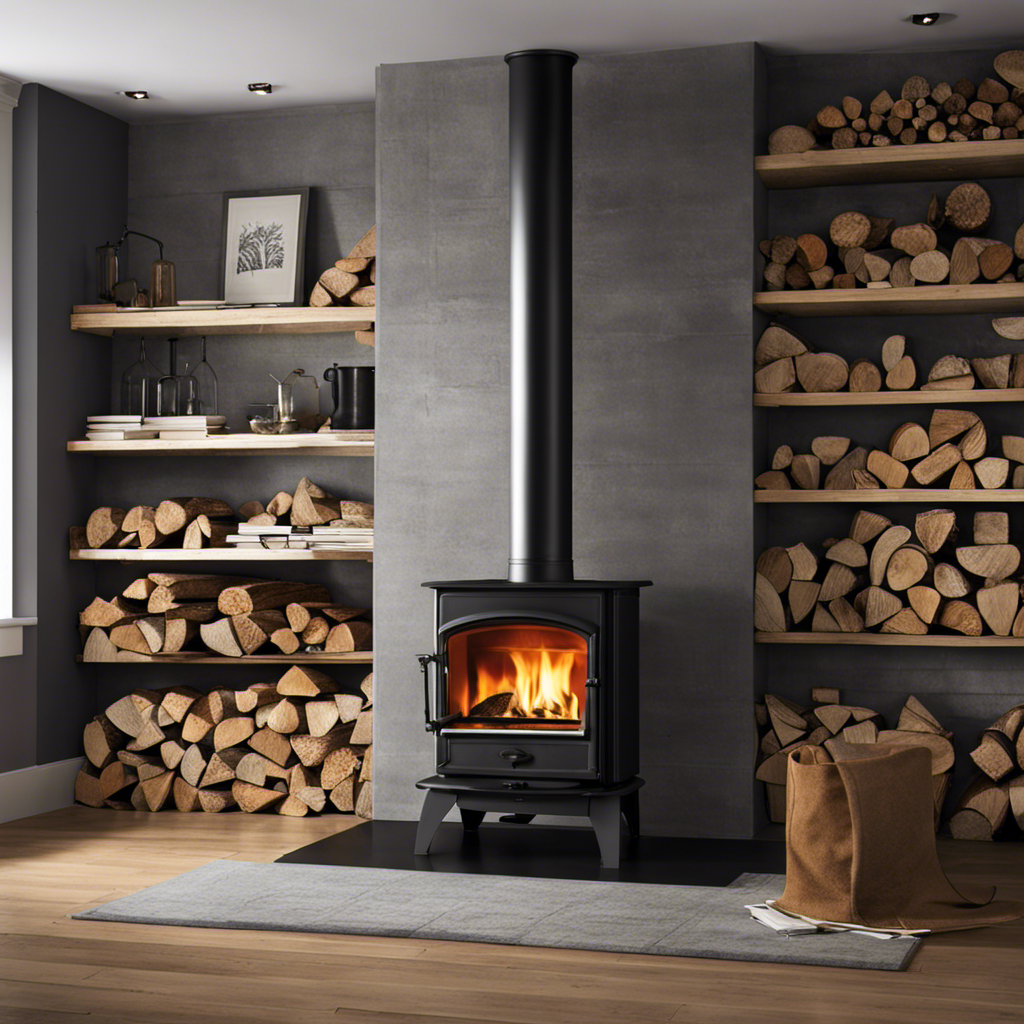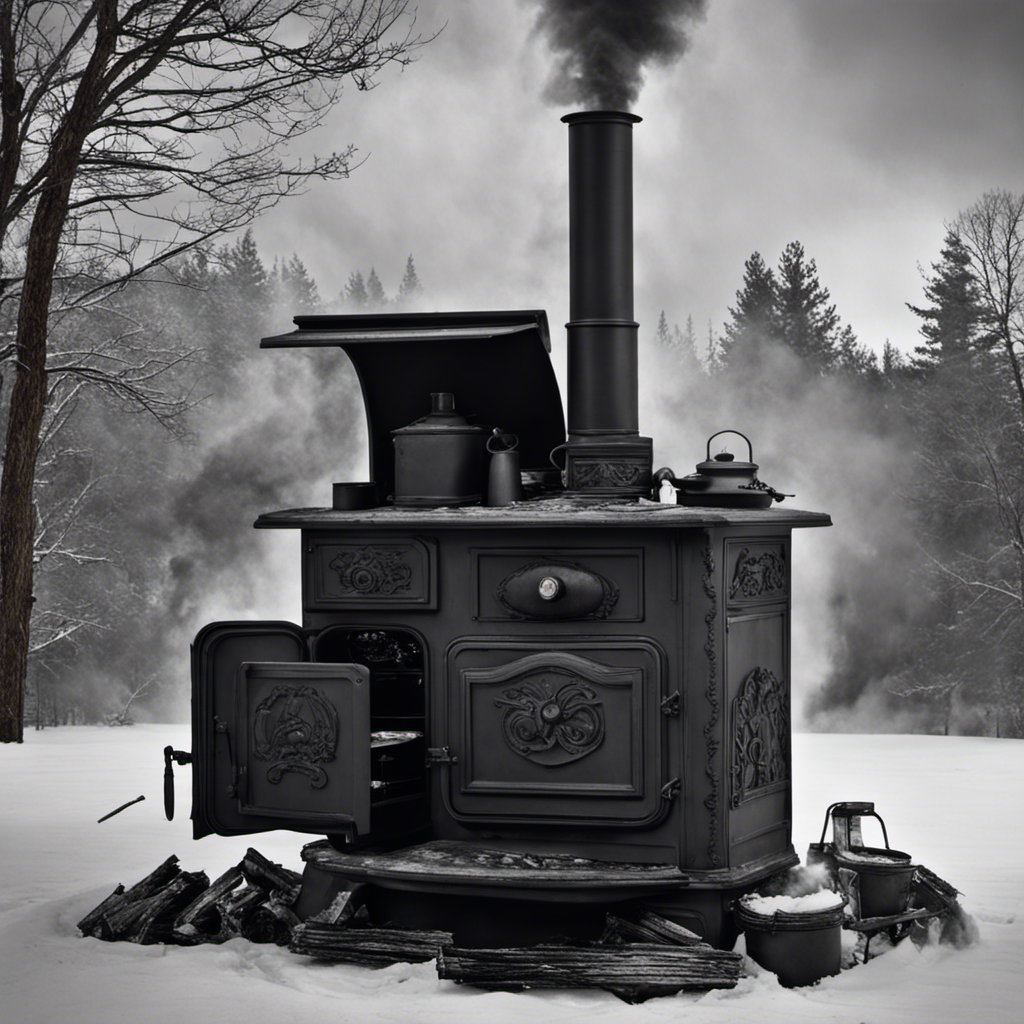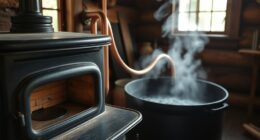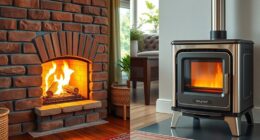Wood stove efficiency ratings tell you how well a stove converts fuel into usable heat, typically ranging from 67% to 83%. Higher ratings mean better heating efficiency and lower energy costs. You'll encounter two main types of ratings: EPA ratings, which indicate emissions and performance under controlled tests, and real-world efficiency ratings that reflect actual usage. Factors like fuel quality, maintenance, and environmental conditions also affect efficiency. Understanding these ratings can help you choose the right stove for your heating needs. Stick around to discover more about what these numbers can really mean for your home.
Key Takeaways
- Wood stove efficiency ratings range from 67% to 83%, indicating how effectively fuel is converted into usable heat.
- Non-catalytic stoves have efficiencies of 67%-75%, while catalytic stoves can achieve 75%-83% efficiency.
- High Efficiency ratings lead to reduced heating costs and improved comfort in homes.
- The EPA sets emissions limits to improve air quality, with modern stoves designed to comply with stricter regulations.
- Efficiency ratings can differ between EPA testing conditions and real-world performance, so consider both for accurate assessments.
Importance of Efficiency Ratings
When you're considering a wood stove, understanding efficiency ratings is essential for making an informed choice. Efficiency ratings indicate how much of the fuel you burn converts into usable heat, with higher ratings—typically between 67% and 83%—signifying better performance.
For instance, the BTU rating of the Englander 10-Cpm shows how efficiency can enhance heating capabilities. This directly translates to reduced energy costs and increased comfort in your home.
The Environmental Protection Agency (EPA) has established standards for emissions and efficiency, emphasizing the importance of efficiency in minimizing environmental impact. By focusing on efficiency ratings, you can compare different stove models effectively, as testing methods and fuel types can lead to discrepancies in reported figures.
It's important to recognize that real-world performance may differ from laboratory tests. Non-catalytic stoves usually show efficiency ratings between 67% and 75%, while catalytic stoves can reach 75% to 83%.
This variability underlines the necessity of context when interpreting these ratings. Ultimately, a stove's efficiency rating can greatly influence your heating costs and overall comfort, making it a critical factor in selecting the right heating appliance for your home.
Types of Efficiency Ratings
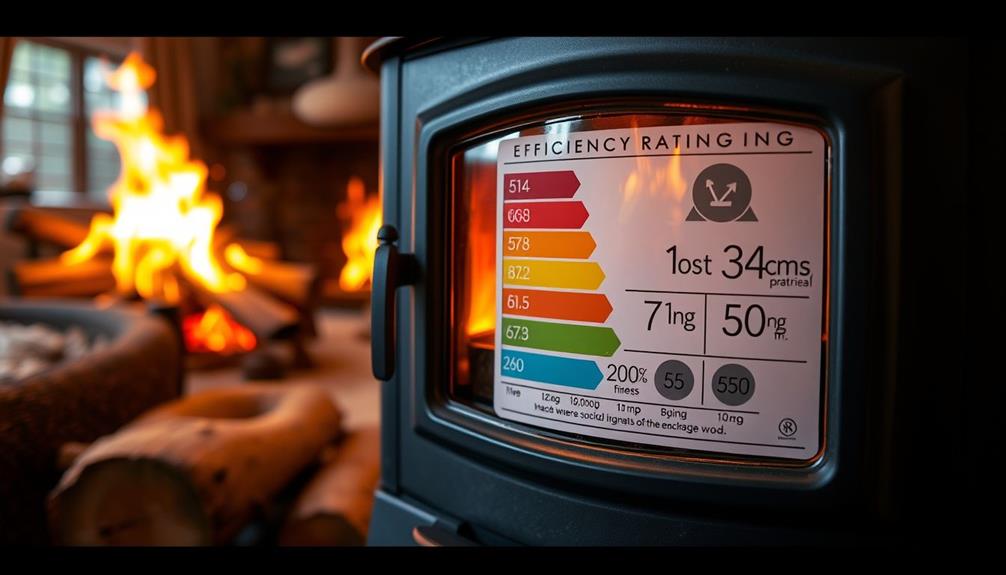
Understanding the types of efficiency ratings is essential for selecting the right wood stove. There are primarily two categories of efficiency ratings you should be aware of: EPA ratings and real-world efficiency ratings. EPA ratings focus on emissions and efficiency under standardized testing conditions, expressed as a percentage. This percentage indicates how much usable heat you can derive from the total heat potential of the fuel consumed.
Additionally, investing in a wood stove can provide potential tax advantages associated with IRA accounts that might be beneficial for your overall financial strategy.
Non-catalytic wood stoves generally have efficiency ratings ranging from 67% to 75%, while catalytic stoves boast higher efficiencies, between 75% and 83%. However, keep in mind that different manufacturers might use varying testing methods for these ratings, leading to discrepancies in reported figures. This is why it's important to research and compare models carefully.
Additionally, total efficiency ratings measure the heat delivered to your home against the fuel consumed, which is often more relevant than combustion efficiency when you're evaluating options for home heating. By understanding these efficiency ratings, you can make more informed decisions about which wood stove will best meet your heating needs.
Understanding High Vs. Low Heating Value
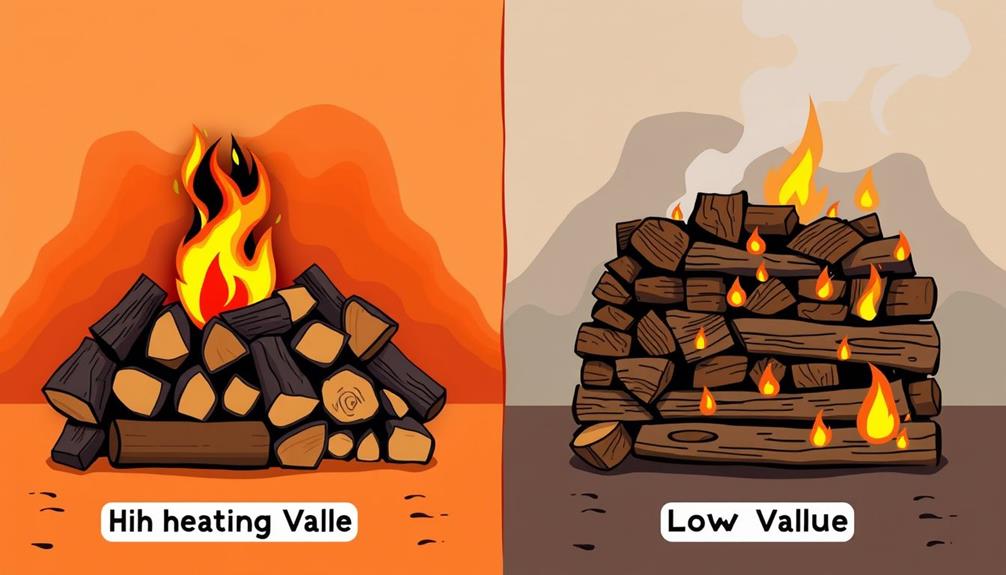
In the world of wood stoves, differentiating between High Heating Value (HHV) and Low Heating Value (LHV) is vital for making informed decisions. The high heating value measures the total heat produced when wood burns, including the heat of vaporization of water. Typically tested at 19%-25% moisture content, HHV provides a realistic indicator of heating performance for consumers, similar to how geothermal energy utilizes the earth's internal heat for efficiency.
On the other hand, LHV only considers the usable heat, excluding the heat of vaporization, and is often tested at 0% moisture content. This can lead to artificially high efficiency numbers that may mislead you.
The Environmental Protection Agency (EPA) recognizes HHV as a standard for evaluating wood heating performance, while LHV is not, adding to the confusion regarding actual heating efficiency.
Since burning wood with moisture content higher than 0% is common, relying on HHV gives you a more accurate reflection of real-world performance in home heating.
Many manufacturers don't specify which heating value they use in their efficiency ratings, so it's important to ask whether they're referencing HHV or LHV when evaluating stove performance. This will guarantee you make a truly informed choice.
Factors Influencing Efficiency
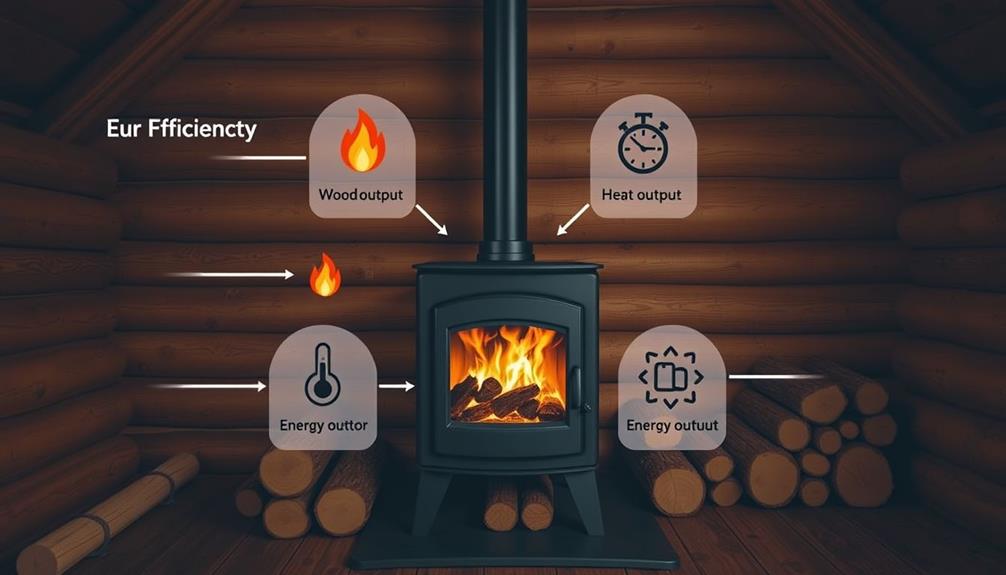
Efficiency in wood stoves often hinges on several key factors that can greatly impact performance. One vital aspect is the placement of ducts. If your ducts are in conditioned spaces, you'll minimize heat loss, while poorly placed ducts can result in losses of up to 20%.
Regular maintenance is also essential for preserving stove efficiency; cleaning components prevents build-up that hinders performance. For ideal home heating solutions, consider the importance of choosing a service that specializes in efficient systems to keep your environment comfortable.
The quality of the fuel you use plays a notable role, too. Burning dry wood is essential for ideal combustion efficiency and heating output. If you burn wood with high moisture content, you'll notice a drop in performance.
Additionally, external factors shouldn't be overlooked. Local climate conditions and the quality of your home's insulation can affect your stove's overall efficiency. Poor insulation can lead to increased heating demand, forcing your stove to work harder than necessary.
Lastly, while stove operation modes are important, remember that high burn rates generally yield better efficiency, though they can increase venting losses. By understanding and managing these factors, you can considerably enhance your wood stove's efficiency, ensuring you get the most out of your investment.
Operating Modes of Wood Stoves
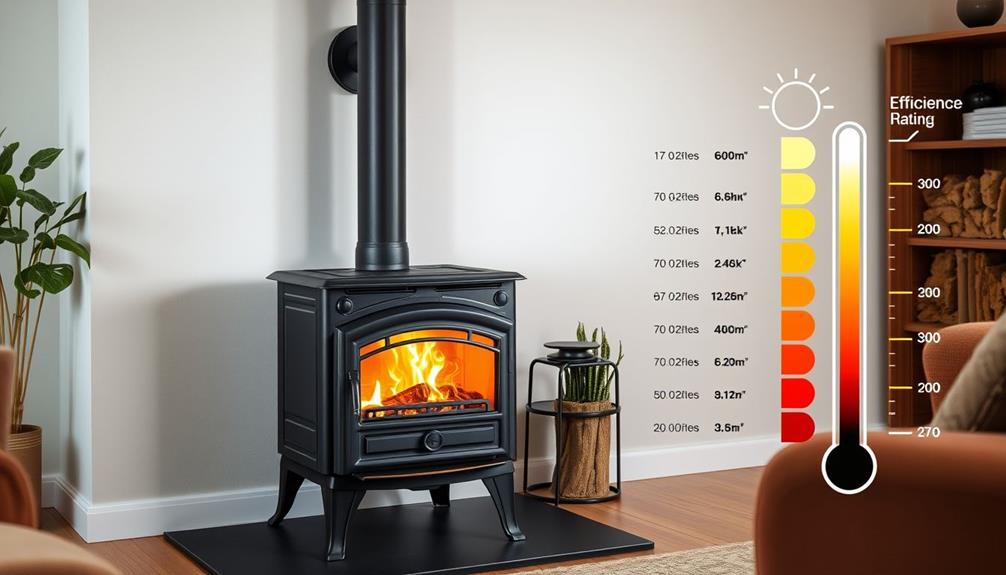
When you use a wood stove, you'll notice two main operating modes: low burn and high burn.
In low burn mode, you'll maintain steady temperatures, which can be beneficial for consistent heating, but it mightn't be the most efficient choice.
On the other hand, high burn rates can heat your space quickly, though they require careful management to avoid heat loss.
Understanding the impact of heat pump performance can provide insights into optimizing your heating methods for greater efficiency.
Low Burn Mode
Operating a wood stove in low burn mode can be beneficial for maintaining steady temperatures and enhancing fuel efficiency. This mode prolongs the burn time of your fuel, allowing for a consistent release of heat over an extended period.
While it's great for moderate heating needs, keep in mind that low burn can lead to incomplete combustion, which may produce more creosote. This means you'll need to perform chimney maintenance more frequently. Additionally, just as improper items can lead to plumbing issues, certain materials can also affect combustion efficiency; for instance, burning wet wood can lead to increased emissions and creosote buildup flushing improper items.
In low burn mode, your stove typically operates with reduced airflow, which can decrease its overall efficiency in converting fuel to heat compared to variable burn settings. If you consistently run your stove in this mode, you mightn't maximize its efficiency, which could lead to increased emissions. This can impact air quality, so it's essential to balance your heating needs with the stove's operational modes.
While enjoying the benefits of low burn, consider the potential downsides, like less heat output and the need for more maintenance. Understanding how to effectively use low burn mode can help you create a cozy atmosphere while being mindful of your stove's performance.
High Burn Rate
Achieving ideal heat output with your wood stove often involves utilizing high burn rates, which can quickly warm larger spaces. By operating in high burn mode, you can maximize combustion rates, improving efficiency and reducing unburned fuel and particulate emissions. This approach not only heats effectively but also enhances your stove's overall performance.
In a farmhouse setting, where open spaces and natural light are emphasized, efficient heating is vital for maintaining comfort throughout the home. By creating a cozy atmosphere with your stove, you can complement the key elements for farmhouse bedroom design that prioritize comfort and warmth.
However, managing high burn rates is essential. If not handled properly, you might experience increased venting losses. Here are some tips to keep in mind:
- Adjust fan speeds and airflow settings to maintain ideal combustion.
- Monitor your stove's temperature to prevent overheating.
- Verify your wood is seasoned for better combustion.
- Regularly clean your stove to avoid buildup affecting efficiency.
- Consider your stove's design and installation to maximize performance.
When using pellet stoves, you'll find that higher efficiencies often occur at elevated burn rates compared to low burn modes. Embrace the high burn rate wisely, and you'll enjoy a cozy, warm home while maximizing high efficiency.
Maintenance for Optimal Performance

To keep your wood stove running efficiently, regular cleaning practices are essential. This includes checking for buildup in the flue and ensuring that air circulation is ideal, as poor airflow can lead to inefficient burning.
You should also prioritize using quality fuel, as it greatly affects performance and maintenance frequency. Additionally, consider the benefits of using ozone air purifiers for improved air quality in your home.
Regular Cleaning Practices
Regular cleaning practices are vital for maintaining your wood stove's efficiency and safety. Neglecting this significant upkeep can lead to a dangerous build-up of creosote, which not only increases the risk of chimney fires but also reduces your stove's overall performance.
To keep your wood stove running smoothly, follow these guidelines:
- Clean the flue and chimney at least once a year, or more often if you use the stove heavily. Regular maintenance guarantees longevity and efficiency, similar to how pool heater maintenance can enhance performance.
- Remove ash ideally after every use or every few days of operation to prevent obstruction of airflow.
- Wipe the glass door with a non-abrasive cleaner periodically to guarantee visibility and proper heat distribution.
- Inspect seals and gaskets regularly for wear, enhancing combustion efficiency and extending your stove's lifespan.
- Schedule a professional inspection if you notice any unusual performance issues.
Quality Fuel Selection
Choosing the right fuel for your wood stove is essential for maintaining its efficiency and maximizing performance. Opt for high-quality fuel, such as seasoned hardwood with a moisture content of 19%-25%. This type of wood enhances combustion efficiency and maximizes heat output.
Additionally, selecting the right fuel is similar to picking the best dog names and breeds for your furry companion, as both choices can greatly impact overall satisfaction. On the other hand, using low-quality or green wood leads to increased creosote buildup, reducing stove efficiency and raising emissions, which could create safety hazards.
Proper fuel storage is also key. Keep your wood in a cool, dry place to prevent moisture absorption, ensuring it burns well when you need it.
Regularly inspect and clean the stove's combustion chamber to improve airflow; this maintenance is vital and can be influenced by the quality fuel selection you make. Additionally, pay attention to the ash content of your fuel. Choosing pellets with lower ash content can decrease your cleaning frequency and enhance overall efficiency.
Professional Installation Importance
Selecting high-quality fuel is just one part of guaranteeing your wood stove operates efficiently.
Professional installation plays an important role in maximizing that efficiency. When a qualified technician handles your stove setup, they make sure everything's positioned correctly, minimizing heat loss and enhancing performance. Misplaced ducts can lose up to 20% of heated air, so the right placement is vital.
Here are some key benefits of professional installation:
- Optimized duct placement for better heat distribution
- Reduced risk of airflow issues that can hinder efficiency
- Compliance with safety standards to keep your home safe
- Regular maintenance and inspections to extend your stove's lifespan
- Expert advice tailored to your home's layout
Environmental Impact of Emissions

Wood stove emissions greatly impact air quality and public health. When you burn wood, harmful pollutants like carbon monoxide and particulate matter are released into the atmosphere. These emissions contribute to respiratory issues and environmental degradation, making it vital for you to be aware of what your wood stove emits.
The EPA has made strides to combat this by setting stringent emissions limits, reducing the allowable particulate emissions from 4.5 g/hr to 2.5 g/hr by May 2020. Modern wood stoves, especially hybrid models, typically burn cleaner than older non-catalytic designs, markedly lowering emissions while maintaining high efficiency.
However, keep in mind that real-world performance can vary based on the quality of the fuel and its moisture content, which means you need to choose your wood wisely.
As the EPA continuously updates regulations, manufacturers are held accountable for complying with evolving standards for cleaner combustion. By understanding these emissions and their environmental impact, you can make informed decisions that contribute to better air quality and public health.
Your choice of wood stove matters—not just for efficiency, but for the environment, too.
Comparing Wood Stove Brands
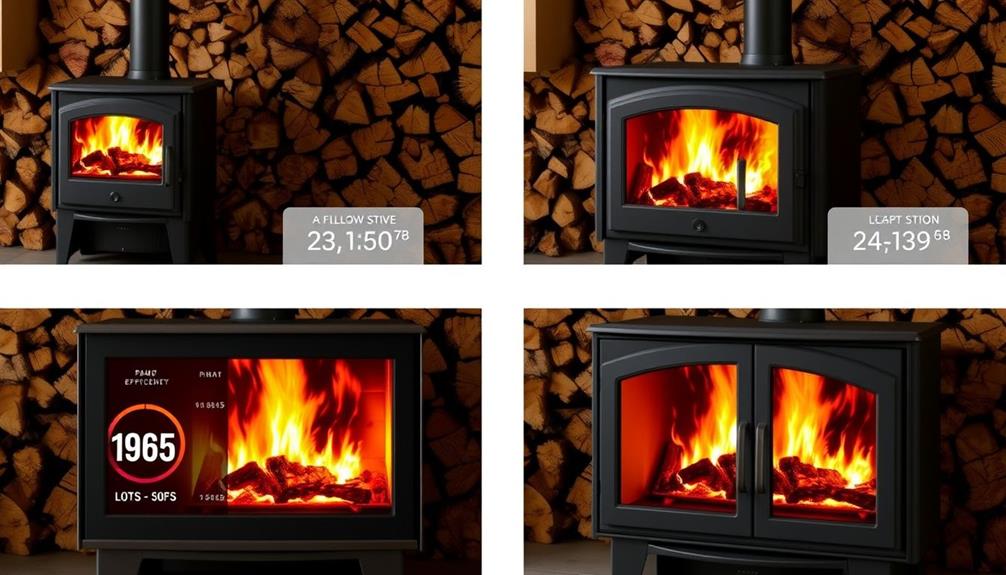
When comparing wood stove brands, you'll want to look closely at their efficiency ratings and how they stack up against emissions standards.
Some brands may shine in efficiency but falter in compliance, while others might prioritize transparency in fuel type considerations.
Understanding these factors will help you make an informed choice for your heating needs.
Brand Efficiency Comparisons
Comparing wood stove brands involves more than just looking at aesthetics; it's crucial to evaluate efficiency ratings and emissions standards.
You'll want to explore how each brand stacks up regarding performance, as these can vary considerably. For instance, while non-catalytic wood stoves often sit between 67% and 75% efficiency, catalytic models can offer up to 83%.
Here are some key points to examine when choosing your wood stove:
- EPA Emissions Ratings: Look for models that meet the 2.5 g/hr standard.
- Real-World Efficiency: Brands may report efficiency using milled lumber, but check real-world performance with cordwood.
- High-Efficiency Models: Some brands can drastically lower your energy consumption and utility bills.
- Catalytic Combustor Durability: Hybrid stoves may maintain efficiency for over nine years.
- Brand Reputation: Research customer reviews and long-term performance to gauge reliability.
Taking the time to compare these factors can help you find a wood stove that not only looks good but also delivers on efficiency and effectiveness, ensuring you get the most value for your investment.
Emissions Standards Compliance
Understanding emissions standards compliance is vital for anyone looking to purchase a wood stove. The EPA has set stricter emissions limits for wood-burning appliances, reducing the allowable emissions from 4.5 g/hr to 2.5 g/hr by May 2020. This change guarantees that newer models are designed with updated environmental standards in mind.
When comparing wood stove brands, it's crucial to highlight that all Kuma Stove models are certified under current EPA standards, reflecting their dedication to cleaner burning technologies.
If you're considering hybrid stoves, take a look at options like the K-180 Series. These stoves emit considerably lower levels of pollutants compared to traditional non-hybrid models, thanks to advancements in emissions technology.
The use of catalytic combustors in hybrid stoves allows for cleaner burning at lower temperatures, which further reduces particulate emissions while improving overall efficiency.
Remember, compliance with emissions standards not only enhances air quality in your home but also aligns with broader sustainability goals.
Fuel Type Considerations
Choosing the right fuel type can greatly impact your wood stove's efficiency and performance. When it comes to wood, the type and quality you use directly affect the burn rate and overall efficiency of your stove.
For instance, hardwood typically burns longer and hotter than softwood, providing more BTUs due to its density and lower moisture content.
Here are some key considerations for selecting fuel:
- Wood Type: Opt for hardwoods like oak or maple for better heat output.
- Moisture Content: Use seasoned wood with less than 20% moisture to maximize efficiency.
- Burn Rate: Understand how different fuels influence how quickly they burn and how much heat they produce.
- Brand Variability: Different brands may have varied testing methodologies, so check for accurate comparisons.
- Real-World Performance: Remember that EPA ratings are based on controlled tests, which can differ from your actual burning conditions.
Regulatory Standards for Efficiency
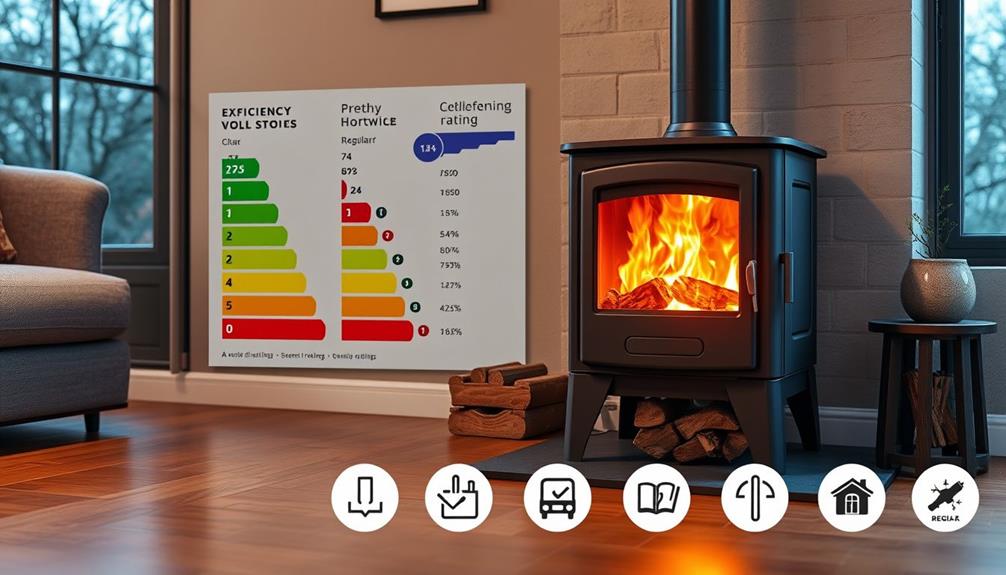
Regulatory standards for wood stove efficiency play a crucial role in reducing emissions and promoting cleaner air. The Environmental Protection Agency (EPA) has set strict emissions limits for wood-burning appliances, requiring a maximum of 2.5 grams of particulate matter per hour for stoves manufactured after May 2020.
This regulation guarantees that the stoves you choose aren't only efficient but also environmentally friendly.
The New Source Performance Standards (NSPS) have evolved since their introduction in 1988, continually tightening emissions regulations for wood-burning appliances. By complying with these standards, manufacturers like Kuma Stoves assure that their models meet the latest efficiency and emissions requirements.
In Ireland, Building Regulations Part L aligns with the EU's Ecodesign requirements, mandating minimum efficiency standards for stoves.
This legislation encourages the adoption of cleaner heating technologies. Additionally, the Sustainable Energy Authority of Ireland (SEAI) offers grants to support homeowners in shifting to energy-efficient heating systems, helping you meet these regulatory standards.
Tips for Choosing Efficient Stoves
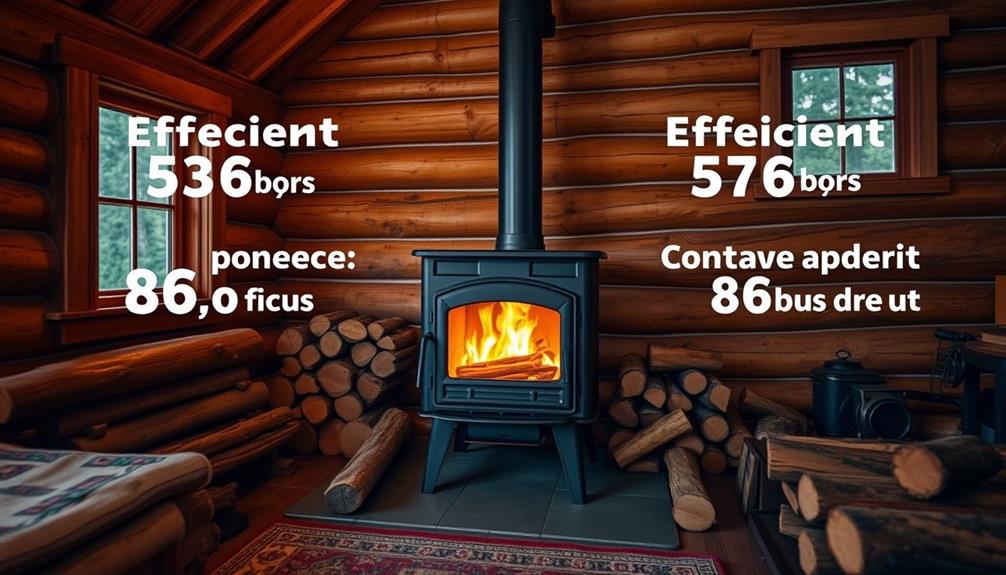
With the right information in hand, selecting an efficient wood stove can greatly enhance your home's heating experience while being environmentally responsible.
To make the best choice, keep these tips in mind:
- Look for efficiency ratings between 67%-83% for catalytic stoves, guaranteeing superior heat retention and lower emissions.
- Prioritize models certified under the latest EPA standards, which limit emissions to 2.5 g/hr, contributing to improved air quality.
- Check the BTU output; an ideal range of 15,000-50,000 BTUs will guarantee your stove meets your heating needs without wasting fuel.
- Research the type of wood you plan to use; burning dry wood with a moisture content below 20% maximizes efficiency and minimizes creosote buildup.
- Read user reviews to find models that not only promise high efficiency ratings but also maintain performance over time and require minimal maintenance.
Frequently Asked Questions
What Is a Good Efficiency Rating for a Wood Stove?
A good efficiency rating for your wood stove falls between 67% and 83%. Non-catalytic models usually hit 67%-75%, while catalytic ones can reach 75%-83%. Higher numbers mean better heat retention and lower heating costs.
What Is 80% Efficient Wood Burning Stove?
An 80% efficient wood-burning stove converts most of the wood's heat into warmth for your home. You'll save on fuel costs and reduce emissions, enjoying a cozy atmosphere while being environmentally friendly.
What Is a Good BTU Rating for a Wood Stove?
A good BTU rating for your wood stove typically ranges from 15,000 to 50,000. It depends on your space size; larger rooms need higher BTUs for effective heating, ensuring your comfort throughout the day.
What Is 90 Percent Efficient Wood Stove?
Think of a 90 percent efficient wood stove as a master chef, crafting heat from wood with precision. You'll enjoy cozy warmth while using less fuel, but remember, real-world conditions can affect that efficiency.
Conclusion
In the grand tapestry of home heating, choosing a wood stove is like selecting a trusted companion for chilly nights. By understanding efficiency ratings and their underlying meanings, you're not just ensuring warmth—you're embracing responsible comfort. Remember, a well-chosen stove can dance gracefully with the environment while keeping your space cozy. So, as you commence on this journey, let the numbers guide you to a snug haven where warmth and wisdom intertwine beautifully.

